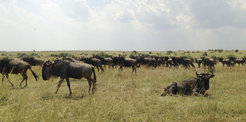Human-Wildlife Interactions in East Africa: Tracking Wildebeest Mobility in the Context of Pastoral Expansion
As pastoralism spread through East Africa, herders and their livestock encountered new wildlife species and new diseases. Epizootiological challenges likely had significant consequences for both the trajectory of pastoral expansion and wildlife biogeographies. This project uses stable isotope analysis of ancient wildebeest teeth to examine the role of pastoralism in the disappearance of wildebeest from Central Rift Valley grasslands.

Recent research has documented the negative impacts of food-producing economies on wildlife populations in East Africa. However, archaeological evidence testifies to the presence of pastoral populations in south-central Kenya since 3000 BP, indicating a long history of interaction between local wild species on the one hand, and cattle, sheep, and goats, and the people that herd them on the other. Stable isotope analysis is a powerful tool for exploring questions surrounding the history of wildlife and food-producing populations. What were the impacts of initial food production in East Africa on wildlife populations? Conversely, did wildlife species encountered by early herders hinder the spread of pastoralism through East Africa? This project utilizes carbon, oxygen, and strontium stable isotope analysis to explore one such instance of human-wildlife interactions by tracking shifts in wildebeest migrations and patterns of local extinction in the context of pastoral expansion in Kenya.
The movement of pastoralism into Kenya’s Central Rift between 4500 and 3000 BP may have been slowed by novel diseases endemic to East Africa (Gifford-Gonzalez 2000; 2015). Wildebeest present one such disease challenge. Neonatal wildebeest communicate wildebeest-derived malignant catarrhal fever (WD-MCF), which is extremely fatal to cattle. Pastoralists today understand the etiology of WD-MCF and cope by driving wildebeest away from cattle grazing grounds and avoid herding in areas where wildebeest calve. Today, wildebeest have a well-known annual migration pattern within protected areas, from the Serengeti Plains of Tanzania to the Mara and, to a lesser extent, the Athi-Kapiti plains in Kenya. Several resident populations also exist, including in the Loita Plains and the Ngorongoro Conservation Area. Wildebeest are currently not found north of these parts of Kenya, nor did early explorers describe them elsewhere. However, archaeological sites document their presence as far north as Lake Baringo until the second millennium BP.
Given the considerable threat posed by wildebeest to herders, pastoral extirpation of wildebeest populations from the prime grazing areas of the Central Rift Valley is one likely cause of their shifting biogeography over time. Stable isotope analysis can inform on the migrations and life histories of ancient wildebeest. Sampling enamel sequentially along the growth axis of high-crowned teeth can reveal the cyclic seasonal patterns in diet and mobility, thus tracking animal movements across the landscape throughout the year. This project analyzes wildebeest tooth enamel from several sites in Kenya and Tanzania spanning the late Pleistocene through the Holocene, providing a record of wildebeest migrations over time, thus documenting shifts in migration patterns or local extinctions of wildebeest populations during the period of initial pastoral expansion in Kenya. By identifying ancient wildebeest calving patterns we can also assess whether disease challenges did indeed hinder the spread of herding, providing a clearer picture of the long history of herders and wildlife in East Africa.
Related Publications
Gifford-Gonzalez, D. 2000. Animal disease challenges to the emergence of pastoralism in Sub-Saharan Africa. African Archaeological Review 17(3):95-139.
Gifford-Gonzalez, D. 2016. "Animal disease challenges” fifteen years later: The hypothesis in light of new data. Quaternary International.
